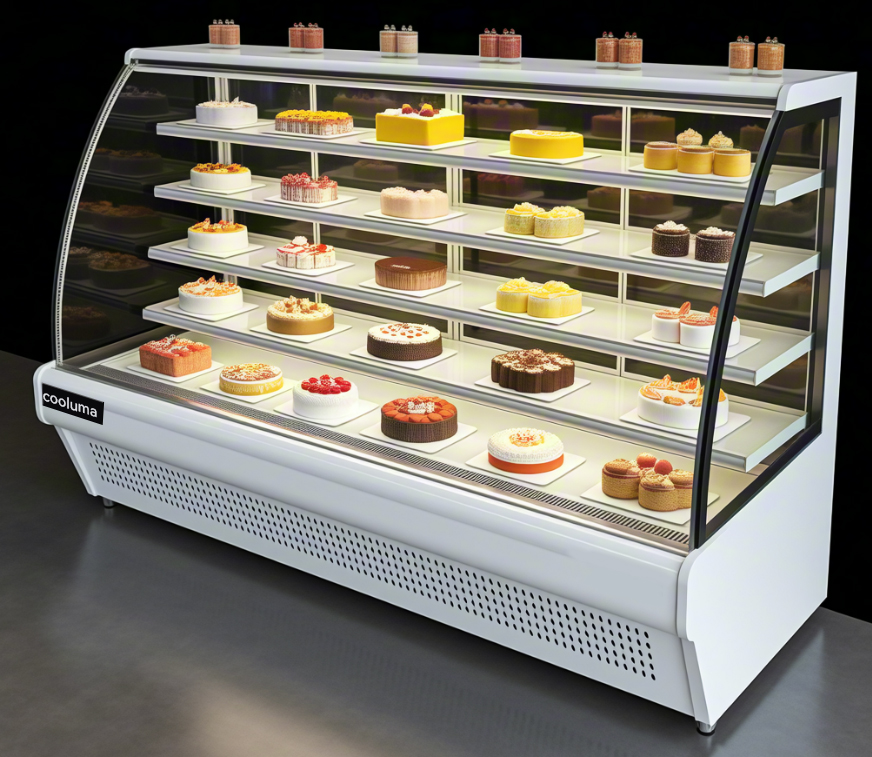The process begins with design conceptualization, where engineers collaborate with food industry experts to define specifications. Key considerations include display requirements (glass visibility, shelving layout), refrigeration needs (temperature range 2-10°C), and structural durability (stainless steel thickness, load-bearing capacity of shelves).

3D modeling software (e.g., AutoCAD, SolidWorks) is used to create detailed blueprints, simulating airflow patterns to ensure uniform cooling and humidity distribution (60-75% RH). Prototypes are often 3D-printed to test ergonomics, such as door opening angles and shelf adjustability.

1. Material Selection and Preparation
Frame and Exterior: Food-grade stainless steel (304 grade) is chosen for its corrosion resistance and easy cleaning. Sheets are cut to size using laser cutting machines, with tolerances as tight as ±0.5mm to ensure precise assembly.
Glass Components: Tempered glass (4-6mm thickness) with anti-fog coatings is selected for doors and front panels. Curved glass sections (for aesthetic appeal) are heated and molded in specialized furnaces, then annealed to reduce brittleness.
Insulation Materials: High-density polyurethane foam (PU foam, density ≥40 kg/m³) is used for walls and doors to minimize heat transfer, with environmentally friendly refrigerants (R134a or R600a) chosen for the cooling system.
2. Cabinet Assembly
Frame Construction: Stainless steel components are welded or riveted together to form the cabinet skeleton. Weld seams are ground smooth to prevent bacteria buildup, then polished to meet food safety standards (compliant with FDA or EU 10/2011 regulations).
Insulation Installation: Foam is injected into the frame cavities and allowed to expand, creating a seamless insulation layer. This step requires strict temperature control (20-25°C) to ensure proper foam curing.
Door Fitting: Hinges (stainless steel or brass) are mounted to attach glass or solid doors, with adjustments made to ensure airtight sealing—critical for maintaining consistent internal temperatures.
3. Refrigeration System Integration
Compressor and Condenser: The heart of the cooling system, typically a hermetic compressor (1/4 to 1/2 HP for medium-sized cabinets), is mounted at the base or rear. Condensers (either air-cooled or water-cooled) are connected via copper tubing, with refrigerant lines brazed to prevent leaks.
Evaporator and Airflow Design: Evaporator coils (often finned to maximize surface area) are installed inside the cabinet, paired with fans to circulate cold air. For dual-zone models, separate evaporators and dampers are added to control humidity in cake and pastry sections.
Thermostat and Sensors: Digital temperature controllers (with ±1°C accuracy) and humidity sensors are wired into the system, linked to a control panel that allows users to adjust settings.
4. Interior Configuration
Shelving Installation: Adjustable chrome-plated wire shelves (or glass shelves for premium models) are fitted, with brackets designed to support 15-20 kg per shelf (to hold heavy cakes).
Lighting Setup: LED strips (warm white, 3000K color temperature) are mounted along the top and sides of the cabinet, with diffusers to prevent glare on glass surfaces. Wiring is concealed within the frame to maintain a clean aesthetic.
Humidity Control Features: Built-in humidifiers (for closed models) or misting system connections (for open-front units) are installed, with water reservoirs placed in easily accessible compartments for refilling.
5. Quality Testing and Certification
Performance Testing: Each cabinet undergoes a 24-hour temperature stability test, with sensors placed at multiple points to ensure the internal range stays within 2-10°C. Humidity levels are monitored similarly, with adjustments made to humidifiers if RH falls below 60%.
Safety Checks: Electrical components are tested for compliance with IEC 60335 (for Europe) or UL 471 (for North America), including insulation resistance and ground continuity. Pressure tests are conducted on refrigerant lines to detect leaks.
Certification: Cabinets that pass testing receive certifications such as CE (for EU markets), NSF (for food contact safety), and Energy Star (for energy efficiency, if applicable).
6. Finishing and Packaging
Surface Treatment: Exteriors are polished to remove fingerprints and smudges, with optional custom finishes (matte black, wood grain) applied via powder coating for specialized orders.
User Manual and Labeling: Instruction manuals (in multiple languages) and safety labels (warning about glass fragility, electrical hazards) are attached. Serial numbers are engraved for traceability.
Packaging: Cabinets are wrapped in polyethylene foam, then placed in wooden crates (ISTA 3A compliant) with corner protectors to prevent damage during shipping. Pallets are used for bulk transport, with load securing to avoid shifting.
From design to delivery, the manufacturing process of cake display cabinets balances technical precision (refrigeration performance) with aesthetic appeal (display functionality), ensuring the final product meets both food safety standards and retail marketing needs.